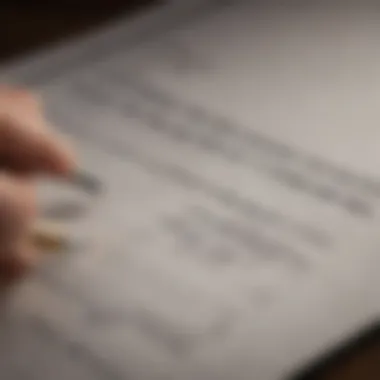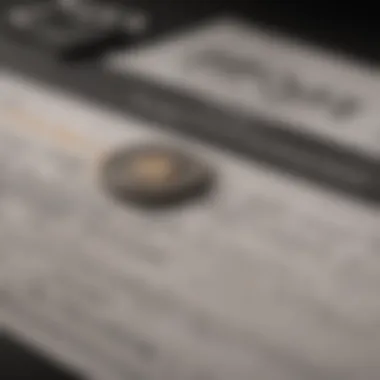A Guide to Voiding Checks: Process and Tips


Intro
Voiding a check can seem like a straightforward task, yet it is a crucial skill that can safeguard one's finances. This procedure is not just about drawing a line through a check; it's a formal action that prevents payment and ensures that funds aren’t unnecessarily deducted from one’s account. Understanding the nuances behind this action is vital, particularly in our fast-paced financial landscape.
When you void a check, you essentially render it useless. However, the reasons for doing so can vary significantly. Perhaps you've made a mistake while filling it out, noted the incorrect payee, or maybe you’ve just changed your mind about the transaction. Regardless, having a clear grasp of how to void a check correctly can save you from future headaches and complications.
In this article, we'll delve deeper into not just the hows but also the whys of the voiding process. Along the way, we’ll explore key tips to enhance your financial literacy, ensuring you manage your checks and transactions securely and efficiently.
Reasons to Void a Check
Understanding why you might need to void a check is just as important as knowing how to do it. Here are a few common scenarios to consider:
- Mistakes on the Check: Errors in the date, amount, or payee can lead to confusion. Voiding the check is a practical way to ensure clarity.
- Changing Payment Methods: Sometimes, situations arise where you need to shift to a different payment option—like moving from a check to electronic transfer.
- Cancelled Transactions: If a service or product isn’t required anymore, voiding the related check helps maintain tight control over your budget.
Remember, voiding a check is like canceling an order before it’s shipped—it stops the transaction before it becomes a problem.
Steps to Void a Check
Now that you understand the reasons, let’s look at how to void a check step by step. The process is relatively simple:
- Write "VOID" Across the Check: Use clear, bold letters to ensure it's easily visible. Be mindful to not alter the essential elements like the date and signature area as they might still be necessary for record keeping.
- Document the Void: Keep a record of the voided check for your personal records. A simple note in your check register showing the date and reason can suffice.
- Notify the Payee: If the check was issued for a specific purpose, it’s wise to inform the payee of the voiding action.
These simple steps can help guarantee that the check won’t be cashed inadvertently.
Important Considerations
When voiding a check, a few considerations are paramount to ensure safety and accuracy:
- Timing Matters: Void the check as soon as you realize there’s an issue. The longer you wait, the higher the chance of the check being processed and paid out.
- Check Your Bank Policies: Some banks have specific procedures regarding voided checks. It's beneficial to familiarize yourself with those policies to avoid confusion later.
- Keep Financial Records: Document all transactions, including voided checks, for easier tracking during budgeting and future reference.
Epilogue
Voiding a check is not just a minor transactional adjustment; it’s a crucial part of managing one’s finances wisely. By incorporating this practice into your financial routine, you not only protect your money but also reinforce the habit of careful and informed financial management. Being aware of when and how to void checks ensures that you maintain control over your available funds, bolstering your financial literacy every step of the way.
Preface to Voiding a Check
In the complex realm of personal finance, voiding a check carries a significance that often goes overlooked. It's not merely about canceling a piece of paper with ink on it; it’s about safeguarding one's financial integrity and maintaining accurate records. The act of voiding essentially communicates that a specific transaction will no longer proceed, thereby preventing the transfer of funds that could lead to complications.
When we consider the life of a check—not just any check, but one that’s faulty, lost, or otherwise compromised—it becomes clear that understanding how to void a check is imperative for effective financial management. This process acts as a safety net, ensuring that, if a mistake occurs—be it in the payee name or the dollar amount—individuals can correct it before it becomes a financial mishap.
Definition of Voiding a Check
Voiding a check is the action taken to render it non-negotiable, effectively declaring it as void. This is typically done when a check is either written incorrectly or must be cancelled for any reason prior to its presentation at a financial institution for cashing or deposit. When a check is voided, a prominent marking of the word "VOID" is placed across the front of the check to make its status crystal clear. This void marking serves to alert anyone handling the check that it is no longer valid and thus cannot be processed.
Importance of Voiding Checks in Financial Management
Understanding the importance of voiding checks reveals its critical role in financial stewardship. This practice promotes accuracy and transparency in financial transactions. Here are some key benefits and considerations:


- Prevention of Errors: Voiding checks promptly helps to erase mistakes before they can impact accounts.
- Record Keeping: Each voided check allows individuals to maintain a clean record. For accounting purposes, having clear documentation of cancelled transactions helps in audits and financial assessments.
- Fraud Prevention: In cases where checks are lost or stolen, voiding prevents unauthorized parties from cashing funds, protecting both personal and business finances.
- Cash Flow Management: By managing which checks are valid and which ones are void, individuals can better track their cash flow and ensure they keep funds available for necessary expenditures.
Being informed about the voiding process not only enhances one’s financial literacy but also fosters a sense of control over monetary dealings. Individuals become empowered to handle their finances responsively and responsibly, safeguarding not just their checkbook but their overall fiscal health.
"Void is not just a word; it’s a shield against financial missteps."
Thus, knowing how and when to void a check is not only beneficial but necessary in the fabric of sound financial management.
Common Reasons for Voiding a Check
When it comes to managing finances, understanding the nuances of checks—especially voiding them—is essential. Voiding a check may seem straightforward, but there are various situations where it becomes necessary. This section digs into some common reasons, enlightening the reader on scenarios in which voiding a check not only makes sense but is often crucial to securing their financial interests.
Mistakes in the Payee Name or Amount
One of the most frequent reasons for voiding a check is an error in the payee name or the amount written on the check. Imagine you’ve just written a check to a local service provider for a hefty sum. However, in your haste, you accidentally wrote the wrong name or miscalculated the total. This can lead to a myriad of complications—ranging from failure to payment being processed, up to potential disputes later on.
To prevent any mix-ups, it's best to double-check the details before finalizing the check. If you do make an error, it’s intelligent to promptly void the check. Simply mark it as "void" and ensure no one can cash it.
Remember: A check that isn't voided can lead to unnecessary confusion, especially if an incorrect check attempts to clear.
Loss or Theft of a Check
Checks can go missing more easily than you might think, whether they fall out of your wallet or get snatched during a busy day. Losing a check carries risks. Should it fall into the wrong hands, there’s a chance that someone could attempt to cash it, draining your funds or causing complications that could mess up your financial records.
In the event of a lost or stolen check, take immediate action. Before anything else, void the check to prevent any unauthorized transactions. It’s advisable to notify your bank about the situation as well; they may help you in tracking the check and advising on further steps to secure your account.
Stop Payments on Specific Transactions
Sometimes, you may find yourself in a situation where you wish to halt payment on a check you’ve previously issued. This could be due to a service not being rendered, dissatisfaction with a product, or just a change of heart. It's vital here to understand that while voiding the check is a route you can take, putting a stop payment through your bank can offer an additional layer of security.
However, voiding the check first helps communicate your intentions clearly. When you request a stop payment, make sure to have the check details at hand. Having the check voided gives you a visual confirmation that it will not be honored, in case there is any dispute later.
Steps to Void a Check Effectively
Void a check may seem like a straightforward action, but doing it correctly is crucial for protecting your finances and ensuring accurate record-keeping. This section breaks down essential steps to effectively void a check, addressing why precision matters.
Review the Check Details
Before you take any action, it's imperative to closely inspect the check you intend to void. This may sound simple, yet overlooking details can lead to unnecessary headaches later. Check for the payee name, amount, and date. Make sure these elements are indeed the reason you're voiding the check.
Is the payee spelled correctly? Does the amount match your intention? These small details can cause significant confusion if left unchecked. Taking just a moment to hand over the check reveals any inconsistencies, helping you feel certain that you are acting appropriately.
Mark the Check Clearly as 'Void'
Next up, marking the check clearly is essential. Use a bold pen and write "VOID" in large, distinctive letters across the front of the check. This step is not just about aesthetics; it's a definitive way to ensure that anyone handling the check afterward understands its status.
Also, remember to draw through the signature area. This extra precaution prevents any potential misuse. The visual impact of marking void is crucial: ensure it’s obvious and unmistakable. Properly voiding the check prevents it from slipping through the cracks and being cashed mistakenly.
Record the Voiding Process


Once you have voided the check, don’t forget to note down this action in your financial records. For instance, if you keep a ledger, make an entry about the check number and the reason it was voided. This gives you a paper trail, which can be handy for reference later.
Also, consider keeping a copy or photo of the voided check in case it’s needed for auditing or any other inquiries. Documenting this process adds a layer of security and clarity, establishing accountability.
If ever in doubt, consult your bank’s policies to ensure compliance with their specific requirements.
Understanding and following these steps ensures that voiding a check does not lead to further complications, enhancing your ability to manage your finances effectively. Having a clear process allows you to proceed confidently and avoid potential pitfalls associated with miscommunication or financial errors.
Digital vs. Paper Checks: Differences in Voiding
When it comes to managing finances, understanding the distinction between digital and paper checks can significantly influence how one handles transactions. The processes of voiding checks differ in subtle yet impactful ways. Grasping these nuances is crucial not just for rectifying mistakes but also for maintaining accurate financial records.
Voiding a Paper Check
Voiding a paper check is a straightforward process, primarily involving physical interaction with the check itself. Here are the steps to follow when dealing with a paper check:
- Locate the Check: It all starts with having the actual check in hand. This is essential since the voiding process requires visible action.
- Marking the Check: Use a bold pen to write the word "VOID" across the face of the check. This helps prevent anyone from attempting to cash it later.
- Documentation: Make sure to keep a record of your voided check. Note the check number, amount, date, and reason for voiding it in your financial records. This provides a clear reference if any discrepancies arise later.
- Inform the Relevant Parties: If the check was intended for a specific payee, notify them of the voiding action. This can save both parties from potential confusion.
One must also keep in mind that once a paper check is voided, it can no longer be reused. Some might find it handy to store these voided checks in a separate file for reference, although others prefer to shred them for security, particularly if sensitive information is present.
Voiding an Electronic Check
Voiding an electronic check is an entirely different ball game, as it occurs within digital systems. Here’s how to navigate the process effectively:
- Access Your Bank Account: Log into your online banking platform where the electronic check was issued. This is usually the first step, similar to accessing a bank branch physically.
- Locate Transaction History: Go to the transaction history to find the specific electronic check you wish to void. This often requires filtering or searching by date or amount.
- Initiate the Voiding Process: Many banking platforms provide an option to void a transaction within their interface. Click on this option and follow the prompts.
- Confirmation: After the voiding request is processed, you should receive a confirmation, usually in the form of an email or a notification on the banking app. Save or print this confirmation as it serves as proof of the action taken.
The electronic aspect makes voiding checks faster, but it's important to remember that these transactions might still appear in bank records until officially settled. Moreover, having a clear line of communication is necessary if the check was initially intended for a payee.
Voiding a check—whether paper or electronic—ensures that your financial records remain tidy, and transactions are managed without hiccups. Each method has its own set of steps and considerations, and understanding them can help you navigate financial responsibilities more effectively.
"Understanding the process of voiding checks, both paper and electronic, allows for greater control and clarity in financial management."
Ultimately, the differences between paper and digital checks emphasize the importance of adapting your approach based on the format utilized. In either case, attentiveness is the key to maintaining accurate financial records.
Implications of Voiding a Check on Financial Records
When one voids a check, they are altering not just a single transaction, but a broader narrative in their financial records. This action holds significant implications for both bank statements and personal accounting. Understanding these implications is vital as it helps individuals maintain accuracy in their financial tracking and avoid future complications.
Impact on Bank Statements
Voiding a check directly influences your bank statements. When this action is taken, the banking institution does not process the check, but it does register the voiding transaction. This means that your bank statement will reflect both the original issued check and the void entry.
- The original check amount is recorded as a debit against your account, but the voiding process mitigates the actual transfer of funds.
- Consequently, your balance may experience temporary fluctuations, leading to potential confusion if not tracked meticulously.
Keeping an eye on notes or annotations on your bank account following a void can help. This ensures clarity and avoids situations where you might forget about a previous transaction, leading to oversights in budgeting or actual spending.
Remember: A clear record of each transaction, whether voided or active, is crucial for sound financial management.


It's best practice to regularly reconcile your bank statements, especially after voiding checks. By ensuring that your records align with bank entries, you can avoid any lingering discrepancies.
Adjusting Your Personal Finance Records
Beyond the bank's records, your personal financial documents require adjustments too. Each voided check must be recorded accurately in your accounting system—whether that’s a spreadsheet, financial software, or simply a ledger.
Here are a few elements to consider when adjusting your records:
- Document the Voided Check: Ensure that you note which check has been voided, including the date and reason for voiding. This clarity can help in future financial analyses.
- Update Your Budgeting Tool: If you use financial management tools, be sure to revise your budget figures. This ensures all parts of your financial picture reflect the voided transaction correctly. Ignoring this might lead to a distorted understanding of your available funds.
- Review Expenses: If a voided check impacts a specific expense category, it may be necessary to revisit your budget allocations. Drawing connections between these entries will illuminate broader patterns in your spending habits.
Ultimately, managing the implications of voiding a check boils down to diligence. In financial dealings, small details often have large consequences. Pay attention to not just the action of voiding a check, but also to how it echoes throughout your broader financial landscape.
Additional Considerations When Voiding a Check
When one embarks on the journey of voiding a check, certain pivotal considerations need to be taken into account. These elements go beyond the mere act of marking a check as void; they weave into the fabric of responsible money management and bolster one's financial literacy. Let's delve into some of these crucial aspects.
Notifying the Payee
It’s vital to inform the payee when you decide to void a check. This isn’t simply a matter of courtesy; it’s an essential practice that prevents confusion and potential negative consequences. When a check gets voided, the payee may be left wondering why they haven’t received the money they expected.
- Importance of Communication: A straightforward email or phone call to the payee can clarify the situation, ensuring that they are aware the original payment isn’t valid anymore. It builds trust and transparency, which are cornerstones of professional and personal relationships.
- Reissuing Payments: In cases where you need to make a payment after voiding a check, notifying the payee allows for smoother transactions. They can adjust their records accordingly and anticipate the new mode of payment, be it cash, a new check, or an electronic transfer.
It’s often said, "A stitch in time saves nine." By taking this simple step to inform the payee, potential entanglements along the line can be avoided, preserving the integrity of the transaction process.
Understanding Possible Fees or Consequences
Every financial action carries implications, and voiding a check is no exception. Knowing the potential fees or consequences before diving in can thwart unpleasant surprises down the line.
- Bank Policies: Different banks have various regulations concerning voided checks. Some may charge fees for processing stop payments or for issuing new checks. It’s essential to consult your bank’s policy beforehand.
- Impact on Financial Records: When a check is voided, it should also be recorded accurately in your personal finance tools or ledgers. Discrepancies can lead to confusion during audits or personal tracking.
- Possible Legal Matters: In rare—and often unfortunate—cases, if the voided check was part of a larger contractual agreement, the act of voiding it might ignite legality issues. It’s wise to consider consulting financial or legal advisors when dealing with significant transactions.
"An ounce of prevention is worth a pound of cure." Being proactive about understanding potential fees or repercussions is a smart approach to maintaining good financial health.
Once these additional considerations are in mind, the act of voiding a check transforms into a more strategic, well-thought-out decision, enhancing both individual confidence and legal protection in financial dealings.
Culmination: Best Practices for Voiding Checks
Successfully voiding a check is more than just a simple action; it is an essential part of maintaining sound financial practices. This conclusion outlines the key practices that allow individuals to efficiently manage their finances and safeguard their transactions.
Summarizing Key Steps
When it comes to voiding a check, understanding the correct procedure is paramount. Follow these summarized steps to ensure efficacy:
- Review the Check Details: It’s crucial to double-check that all the information on the check is correct, including the payee and the amount before moving forward with the voiding process.
- Mark the Check Clearly as 'Void': Utilize a bold black marker to clearly write “VOID” across the front of the check, making sure to keep it visible but not obscuring important details.
- Record the Voiding Process: Maintain thorough records of the check voiding, whether it’s in a ledger, spreadsheet, or another system that you use to track your finances.
Following these steps will not only prevent the accidental negotiation of the check but also keep your records in order. Remind yourself that a clear and careful approach is the best way to avoid future complications or miscommunication.
Encouraging Secure Financial Practices
In addition to technically voiding a check, incorporating safe financial practices can serve to protect your earnings and investments. Here are several key considerations:
- Notify the Payee: If the check was issued but is now voided, communicating this to the intended recipient can prevent misunderstandings. Keeping everyone on the same page about the check's status goes a long way in maintaining trust.
- Consider Possible Fees or Consequences: Be aware of any potential fees that might arise from the voiding of the check. Some banks might have specific policies regarding stop payments or reissuing checks, so it’s prudent to get in touch directly with your bank.
Remember, a proactive approach in financial management is essential to avoiding issues down the line.
Being informed and vigilant when voiding a check creates a ripple effect that enhances your overall financial health. By integrating these best practices into your routine, you can navigate the world of finances with confidence and ease.







